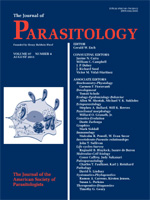A specific fatty acid binding protein was isolated from Giardia lamblia, using an affinity column with butyric acid acting as a ligand in place of stearic acid. This method has proved to be more efficient than the one previously described using stearic acid as ligand. The purified fraction showed 8 electrophoretic bands of proteins, with molecular weights ranging between 8 and 80 kDa. This pattern is a consequence of the aggregation of a protein with a molecular weight of 8,215 Da, corresponding to the lower molecular weight band, the only one capable of binding to fatty acids. The labeled oleic acid bound to these purified proteins was replaced by a 100-fold greater concentration of taurocholate, glycocholate, deoxycholate, palmitic acid, and arachidonic acid, having a greater displacement of the bile salts than the free fatty acids.
How to translate text using browser tools
1 August 2011
Purification and Characterization of a Protein Capable of Binding To Fatty Acids and Bile Salts in Giardia lamblia
R. Diaz de la Guardia,
M. B. Lopez,
M. Burgos,
A. Osuna
ACCESS THE FULL ARTICLE

Journal of Parasitology
Vol. 97 • No. 4
August 2011
Vol. 97 • No. 4
August 2011




